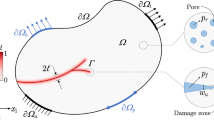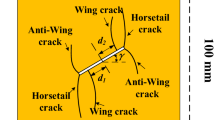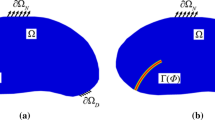Abstract
A new double-phase-field model is proposed in this paper for modeling cracking processes in rock-like brittle materials under compression-dominating stresses. For this purpose, two crack-phase fields are used to describe tensile and shear cracks respectively. Compared with previous works, a stress-based new criterion is proposed to more physically capture the evolution of shear cracks in rock-like materials. The effects of mean stress and internal friction are taken into account. The proposed model is implemented in the finite element framework. It is applied to investigating cracking processes in a rock sample containing two initial flaws and subjected to uniaxial and biaxial compression. Both the tensile wing and shear cracks as well as crack coalescence observed in laboratory tests are successfully reproduced by the proposed method.
Highlights
-
A new phase-field model is developed for modeling complex cracking in rock-like materials under compressive loads.
-
Two damage fields are introduced in order to describe tensile and shear cracks.
-
A new criterion is proposed for the description of shear crack under multi-axial compression.
-
The new model is able to well reproduce complex cracking processes observed in laboratory tests.








Similar content being viewed by others
References
Ambrosio L, Tortorelli VM (1990) Approximation of functional depending on jumps by elliptic functional via t-convergence. Commun Pure Appl Math 43(8):999–1036
Amor H, Marigo J-J, Maurini C (2009) Regularized formulation of the variational brittle fracture with unilateral contact: numerical experiments. J Mech Phys Solids 57(8):1209–1229
Bernard PE, Moes N, Chevaugeon N (2012) Damage growth modeling using the thick level set (tls) approach: efficient discretization for quasi-static loadings. Comput Methods Appl Mech Eng 233–236:11–27
Bleyer J, Alessi R (2018) Phase-field modeling of anisotropic brittle fracture including several damage mechanisms. Comput Methods Appl Mech Eng 336:213–236
Bobet A (1998) Fracture coalescence in rock materials: experimental observations and numerical predictions. Ph.D. thesis, Massachusetts Institute of Technology
Bobet A, Einstein HH (1998) Numerical modeling of fracture coalescence in a model rock material. Int J Fract 92(3):221
Borden MJ, Verhoosel CV, Scott MA, Hughes TJ, Landis CM (2012) A phase-field description of dynamic brittle fracture. Comput Methods Appl Mech Eng 217:77–95
Borden MJ, Hughes TJ, Landis CM, Anvari A, Lee IJ (2016) A phase-field formulation for fracture in ductile materials: finite deformation balance law derivation, plastic degradation, and stress triaxiality effects. Comput Methods Appl Mech Eng 312:130–166
Bourdin B, Francfort GA, Marigo J-J (2000) Numerical experiments in revisited brittle fracture. J Mech Phys Solids 48(4):797–826
Bourdin B, Francfort GA, Marigo J-J (2008) The variational approach to fracture. J Elast 91(1–3):5–148
Bryant EC, Sun W (2018) A mixed-mode phase field fracture model in anisotropic rocks with consistent kinematics. Comput Methods Appl Mech Eng 342:561–584
Choo J, Sun W (2018) Coupled phase-field and plasticity modeling of geological materials: From brittle fracture to ductile flow. Comput Methods Appl Mech Eng 330:1–32
Dean A, Kumar PAV, Reinoso J, Gerendt C, Paggi M, Mahdi E, Rolfes R (2020) A multi phase-field fracture model for long fiber reinforced composites based on the puck theory of failure. Compos Struct 251:112446
Evans B, Fredrich JT, Wong T-F (1990) The brittle-ductile transition in rocks: Recent experimental and theoretical progress. The Brittle-Ductile transition in rocks. Geophys Monogr Ser 56:1–20
Fang J, Wu C, Li J, Liu Q, Wu C, Sun G, Qing L (2019) Phase field fracture in elasto-plastic solids: variational formulation for multi-surface plasticity and effects of plastic yield surfaces and hardening. Int J Mech Sci
Fei F, Choo J (2020) A phase-field method for modeling cracks with frictional contact. Int J Numer Meth Eng 121(4):740–762
Fei F, Choo J (2020) A phase-field model of frictional shear fracture in geologic materials. Comput Methods Appl Mech Eng 369:113265
Fei F, Choo J (2021) Double-phase-field formulation for mixed-mode fracture in rocks. Comput Methods Appl Mech Eng 376:113655
Francfort GA, Marigo J-J (1998) Revisiting brittle fracture as an energy minimization problem. J Mech Phys Solids 46(8):1319–1342
Li Z, Zhu Q-H, Tian B-l, Sun T-F, Yang D-W (2017) A damage model for hard rock under stress-induced failure mode, in: Advanced Engineering and Technology III: Proceedings of the 3rd Annual Congress on Advanced Engineering and Technology (CAET 2016), Hong Kong, 22-23 October 2016, CRC Press, p. 87
Lubarda V, Krajcinovic D, Mastilovic S (1994) Damage model for brittle elastic solids with unequal tensile and compressive strengths. Eng Fract Mech 49(5):681–697
Miehe C (1998) Comparison of two algorithms for the computation of fourth-order isotropic tensor functions. Comput Struct 66(1):37–43
Miehe C, Lambrecht M (2001) Algorithms for computation of stresses and elasticity moduli in terms of seth-hill’s family of generalized strain tensors. Commun Numer Methods Eng 17(5):337–353
Miehe C, Hofacker M, Welschinger F (2010) A phase field model for rate-independent crack propagation: Robust algorithmic implementation based on operator splits. Comput Methods Appl Mech Eng 199(45–48):2765–2778
Miehe C, Welschinger F, Hofacker M (2010) Thermodynamically consistent phase-field models of fracture: variational principles and multi-field fe implementations. Int J Numer Meth Eng 83(10):1273–1311
Miehe C, Hofacker M, Schänzel L-M, Aldakheel F (2015) Phase field modeling of fracture in multi-physics problems. Part ii. coupled brittle-to-ductile failure criteria and crack propagation in thermo-elastic-plastic solids. Comput Methods Appl Mech Eng 294:486–522
Moes N, Dolbow J, Belytschko T (1999) A finite element method for crack growth without remeshing. Int J Numer Methods Eng 46:131–150
Moes N, Stolz C, Chevaugeon N, Bernard PE (2010) A level set based model for damage growth: the thick level set approach. Int J Numer Meth Eng 86:358–380
Mumford D, Shah J (1989) Optimal approximations by piecewise smooth functions and associated variational problems. Commun Pure Appl Math 42(5):577–685
Murakami S (2012) Continuum damage mechanics: a continuum mechanics approach to the analysis of damage and fracture, vol 185. Springer, New York
Na S, Sun W (2018) Computational thermomechanics of crystalline rock. Part i: A combined multi-phase-field/crystal plasticity approach for single crystal simulations. Comput Methods Appl Mech Eng 338:657–691
Nguyen TT, Yvonnet J, Zhu Q-Z, Bornert M, Chateau C (2016) A phase-field method for computational modeling of interfacial damage interacting with crack propagation in realistic microstructures obtained by microtomography. Comput Methods Appl Mech Eng 312:567–595
Nguyen TT, Yvonnet J, Bornert M, Chateau C, Sab K, Romani R, Le Roy R (2016) On the choice of parameters in the phase field method for simulating crack initiation with experimental validation. Int J Fract 197:213–226
Nguyen T-T, Rethore J, Yvonnet J, Baietto M-C (2017) Multi-phase-field modeling of anisotropic crack propagation for polycrystalline materials. Comput Mech 60(2):289–314
Nguyen T-T, Réthoré J, Yvonnet J, Baietto M-C (2017) Multi-phase-field modeling of anisotropic crack propagation for polycrystalline materials. Comput Mech 60:289–314
Oliver J (1996) Modelling strong discontinuities in solid mechanics via strain softening constitutive equations, part 1: fundamentales. Int J Numer Methods Eng 39:3575–3600
Oshima K, Takaki T, Muramatsu M (2014) Development of multi-phase-field crack model for crack propagation in polycrystal. Int J Comput Mater Sci Eng 03:1450009
Palmer A, Rice J (1973) The growth of slip surfaces in the progressive failure of over-consolidated clay. Proc R Soc Lond A Math Phys Sci 332(1591):527–548
Paterson MS, Wong T-F (2005) Experimental rock deformation-the brittle field. Springer, New York
Spetz A, Denzer R, Tudisco E, Dahlblom O (2021) A modified phase-field fracture model for simulation of mixed mode brittle fractures and compressive cracks in porous rock. Rock Mech Rock Eng 54:1–14
Ulloa J, Wambacq J, Alessi R, Samaniego E, Degrande G, François S (2022) A micromechanics-based variational phase-field model for fracture in geomaterials with brittle-tensile and compressive-ductile behavior. J Mech Phys Solids 159:104684
Wang Q, Feng Y, Zhou W, Cheng Y, Ma G (2020) A phase-field model for mixed-mode fracture based on a unified tensile fracture criterion. Comput Methods Appl Mech Eng 370:113270
Wang L, Vuik C, Hajibeygi H (2022) A stabilized mixed-fe scheme for frictional contact and shear failure analyses in deformable fractured media. Eng Fract Mech 267:108427
Wong TF (1982) Micromechanics of faulting in westerly granite. In: International journal of rock mechanics and mining sciences & geomechanics abstracts, Vol. 19, Elsevier, pp 49–64
Wong T-F, Baud P (2012) The brittle-ductile transition in porous rock: a review. J Struct Geol 44:25–53
Wong R, Chau K, Tang C, Lin P (2001) Analysis of crack coalescence in rock-like materials containing three flaws-part i: experimental approach. Int J Rock Mech Min Sci 38(7):909–924
Wu JY, Nguyen VP, Nguyen CT, Sutula D, Bordas S, Sinaie S, Bordas SP (2020) Chapiter one - phase field modeling of fracture. Adv Appl Mech 53:1–183
You T, Waisman H, Zhu Q-Z (2021) Brittle-ductile failure transition in geomaterials modeled by a modified phase-field method with a varying damage-driving energy coefficient. Int J Plast 136:102836
Yu Z, Shao JF, Vu MN, Armand G (2021) Numerical study of thermo-hydro-mechanical responses of in situ heating test with phase-field model. Int J Rock Mech Min Sci 138:104542
Zeng Q, Yao J, JF S (2018) Numerical study of hydraulic fracture propagation accounting for rock anisotropy. J Petrol Sci Eng 160:422–432
Zeng Q, Yao J, JF S (2019) Study of hydraulic fracturing in an anisotropic poroelastic medium via a hybrid edfm-xfem approach. Comput Geotech 105:51–68
Zhang X, Sloan SW, Vignes C, Sheng D (2017) A modification of the phase-field model for mixed mode crack propagation in rock-like materials. Comput Methods Appl Mech Eng 322:123–136
Zhang S, Jiang W, Tonks MR (2020) A new phase field fracture model for brittle materials that accounts for elastic anisotropy. Comput Methods Appl Mech Eng 358:112643
Zhao L, Zhu Q, Shao J (2018) A micromechanics-based plastic damage model for quasi brittle materials under a large range of compressive stress. Int J Plast 100:156–176
Zhao L, Shao J, Zhu Q (2018) Analysis of localized cracking in quasi-brittle materials with a micromechanics based friction damage approach. J Mech Phys Solids 119:163–187
Zhou S, Zhuang X, Rabczuk T (2019) Phase field modeling of brittle compressive-shear fractures in rock-like materials: a new driving force and a hybrid formulation. Comput Methods Appl Mech Eng 355:729–752
Zhu Q, Zhao L, Shao J (2016) Analytical and numerical analysis of frictional damage in quasi brittle materials. J Mech Phys Solids 92:137–163
Acknowledgements
This work has been partially supported by the French National Agency for radioactive waste management (ANDRA), the National Natural Science Foundation of China (Grant No. 12202099).
Author information
Authors and Affiliations
Corresponding author
Additional information
Publisher's Note
Springer Nature remains neutral with regard to jurisdictional claims in published maps and institutional affiliations.
Rights and permissions
Springer Nature or its licensor (e.g. a society or other partner) holds exclusive rights to this article under a publishing agreement with the author(s) or other rightsholder(s); author self-archiving of the accepted manuscript version of this article is solely governed by the terms of such publishing agreement and applicable law.
About this article
Cite this article
Yu, Z., Sun, Y., Vu, MN. et al. Modeling of Mixed Cracks in Rock-Like Brittle Materials Under Compressive Stresses by a Double-Phase-Field Method. Rock Mech Rock Eng 56, 2779–2792 (2023). https://doi.org/10.1007/s00603-022-03196-w
Received:
Accepted:
Published:
Issue Date:
DOI: https://doi.org/10.1007/s00603-022-03196-w




